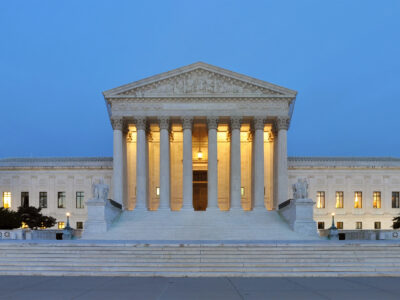What to Expect This Year in Terms of Climate Action
Although there will be many flashing lights and loud noises, 2011 will primarily be a year in which various events that are already in play evolve toward major developments in 2012.
Litigation. The one exceptional major development in 2011 will be American Electric Power (AEP) v. Connecticut, the climate nuisance case that the Supreme Court has agreed to hear. The odds are good that the Court will throw out the case, the interesting question being what ground the Court will choose. It would be very surprising if the Justices relied on the political question, which the trial courts have favored. The easiest basis for dismissal would be that the federal common law of nuisance is preempted by EPA’s actions under the Clean Air Act, but there will surely be a number of Justices who want to dismiss the case on the basis of standing. The question there is whether Justice Kennedy finds this case distinguishable in terms of standing from Massachusetts v. EPA, where he joined the majority ruling in favor of standing.
Predictions are very chancy regarding the votes of individual Justices, but my prediction is that there will be four votes to dismiss the case on the basis of standing (all the dissenters in Mass. v. EPA); very few if any votes to invoke the political question doctrine; and at least one or two votes (most likely Kennedy and Breyer or Kagan) to dismiss on the basis that the federal common law of nuisance has been preempted.
Although AEP will have symbolic importance and could have some interesting legal implications, it won’t have much practical impact — I don’t think the plaintiffs ever had much of a chance of getting an actual remedy anyway given the enormous factual complexities.
With that major exception, 2011 may be light on dramatic developments (though not on noisy fireworks). EPA’s regulations are going into effect in phases, due to the judicial refusal to stay them pending review. Those cases will be briefed and argued sometime in the next months. The appellate court opinions may come down in 2011, but given the complexity of the cases and the fact that they’re all being heard by one three-judge panel, the opinions may not be announced until early 2012. The most important single decision will be the validity of EPA’s endangerment finding, which is the lynchpin for the rest of the efforts. I believe that the court will uphold that finding.
In any event, there will almost certainly be an effort at Supreme Court review, which will at a minimum add several months to the clock. The refusal of a stay was not a great sign for the challengers; at least, it suggests that the appellate court does not regard the regulations as blatantly unlawful.
I don’t think it’s a foregone conclusion that the Supreme Court will hear the EPA cases, given how complex and messy they are. At most, the Court is likely to grant cert. limited to a few key issues. Unless Justice Kennedy changes his mind, those issues will not include the question of whether the Clean Air Act covers greenhouse gases. It will probably be 2012 at least before the judicial process has completed, meaning that EPA will be over a year into the process of implementing the regulations.
Congress. In the meantime, there will be continued efforts in Congress, especially the House, to block or at least postpone the regulations. Senator Rockefeller made an effort to do so in the last session unsuccessfully, but the story could be different in the new Congress. On the other hand, now that some of the regulations have already gone into effect, it may be harder to make the case for postponement. In addition, the GOP may find it hard to mount a major effort here with some many other issues to address.
States. At the state level, the big news will be the rollout of California’s cap-and-trade system. This has been slowly under development and will not be implemented overnight. Other states will continue with their efforts. (Of course, Texas, in line with its usual favoritism toward polluters, won’t be among that group.) Legally, the most difficult issues for California involve regulation of electrical utilities that could impact out-of-state generators (a problem under the dormant commerce clause) or the wholesale electricity market (an issue under federal preemption). Any legal challenges on those bases will take a year or two to resolve.
International. Internationally, the focus is not on the next Conference of the Parties in 2011 but on the 2012 event. So the negotiations will be slowly and quietly trying to lay the groundwork for a major agreement two years from now.
Science. In terms of the science, there is no reason to anticipate major changes. The modeling will continue to improve, and scientists will be devoting major effort to understanding aerosols and clouds better. Studies will appear suggesting that some things are worse than we believed and some are better.
Overall. In the meantime, while all of these political and legal events take place, the atmosphere will continue slowly to absorb more greenhouse gases. The long-term climate situation will continue to deteriorate, and even stronger efforts will be required later because we failed to take greater action so far. But with enormous effort and great political pain, we do seem to be moving slowly in the right direction.






One Reply to “What to Expect This Year in Terms of Climate Action”
Comments are closed.